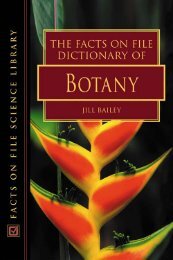You also want an ePaper? Increase the reach of your titles
YUMPU automatically turns print PDFs into web optimized ePapers that Google loves.
3.21 ,-------------,<br />
3.23<br />
3.2J Non-sterile excised root segments of<br />
the dicotyledon AnlJQracia fllsticalla (horse<br />
radish) cultured for several weeks ill vitro.<br />
Note the numerous leafy adventitious buds<br />
which arise from the cork cambium of the<br />
roO[; adventitious roots also arise from this<br />
tls.'me.<br />
,------------=<br />
3.23 TS of the petiole of the dicotyledon Sanicula<br />
europea (sanicle) showing the peripheral lOcation of<br />
coUalchyma (I). This living tissue has thickened cellulosic<br />
walls and its location helps 10 suppOtt the young leaf.<br />
Parenchyma (2), primary phloem (3), primary x}·lem (4).<br />
(L\1 x 60.)<br />
I Collenchyma<br />
2 Parenchyma<br />
3 Primary phloem<br />
4 Primary xylem<br />
3.24 TS of the stem of Coleus (a dicotyledon) showing<br />
detail of the collenchyma. This peripheral tissue (cf., 3.13)<br />
is of the angular form with additional cellulose thickening<br />
deposited al the angles of these cells (d., 3.78). (L:\it x<br />
335.)<br />
68<br />
3.22 TS ofaxeromorphic leaf of of the conifer Pinus (pine) showing the<br />
epidermis and mesophyll. The thin mcsophyll 'ell walls possess numerous<br />
vertical ingrowths (1), but the protoplasts of these cells have become plasnlOlysed<br />
so that a gap separates them from the walls. Note the resin duct<br />
(2) in the mesophyll and also the guard cells (3) which are sunken beneath<br />
the subsidiary cells (4) in the epidermis. (LM:II; 110.)<br />
I Wall ingrowths<br />
2 Resin duct<br />
3 Guard cells<br />
4 Subsidiary cells<br />
3.22





